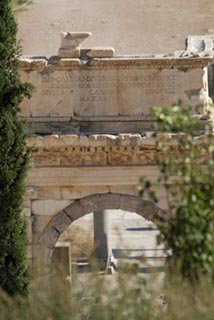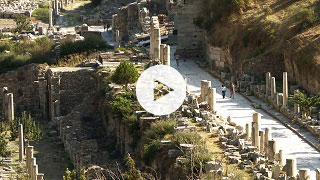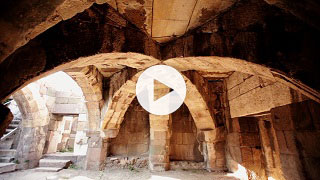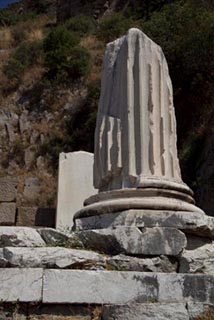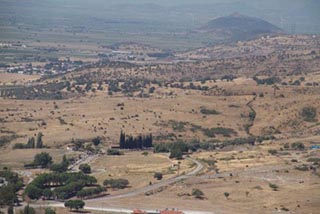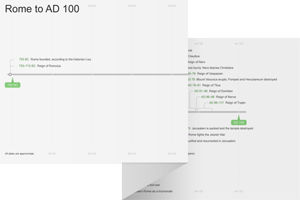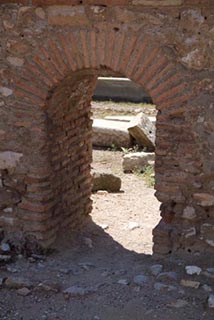2:1 Ephesus Ephesus, the largest city in Asia Minor, was situated where the Cayster River meets the Aegean Sea.
the largest city in Asia Minor, was situated where the Cayster River meets the Aegean Sea. Ephesus was both a major port city and the site of many temples, including a large one dedicated to goddess Artemis (see Acts 19:27 and note).
Ephesus was both a major port city and the site of many temples, including a large one dedicated to goddess Artemis (see Acts 19:27 and note).
 Messages to the Seven Churches of Revelation Table
Messages to the Seven Churches of Revelation Table
the seven stars in his right hand Christ is identified as the speaker at the beginning of each of the addresses to the churches in Rev 2–3; this reflects aspects of John’s introduction in 1:9–20.
2:2 your labor and patient endurance Probably describes the church’s work for the sake of the gospel.
I know Since Christ is among the churches (see 1:13), He knows their deeds.
not able to tolerate evil Initially, they were zealous for righteousness.
you put to the test Likely a defense mechanism to safeguard the purity and livelihood of the church (see Acts 20:29; and see note on 1 John 1:1–4); they were a discerning group of people.
2:3 patient endurance The church was probably encountering opposition, which may have resulted in persecution. Their refusal to conform would have also caused social and political backlash, causing tension in commercial and familial relationships.
because of my name Describes their identification as followers of Jesus.
2:4 I have this against you Christ’s commendation now turns to condemnation.
you have left your first love The church was initially zealous and motivated by love, but that love diminished as time passed. This love could be directed at God or brothers and sisters in the Lord. Their love for unbelievers in the city may have also waned under the heavy hand of persecution.
2:5 repent Condemnation is followed by an exhortation to repentance: abandon sin and return to serving God.
abandon sin and return to serving God.
if you do not Christ moves from exhortation to warning.
I will remove Failure to repent would result in the church’s removal from that place. If a church fails to fulfill its function, it will not continue to exist.
2:6 you do have this Christ commends the church for zealously opposing that which is unjust in favor of righteousness.
deeds of the Nicolaitans Little is known of this group; they are probably not connected to the Nicolaus of Acts 6:5. Given John’s disdain for the religious practices of the Roman Empire, the Nicolaitans may have compromised by allowing pagan religious practices into the church, thereby avoiding persecution and social tension (compare Rev 2:14–15).
may have compromised by allowing pagan religious practices into the church, thereby avoiding persecution and social tension (compare Rev 2:14–15).
things which I also hate Christ hates the deeds of the Nicolaitans and presents them as a threat to the church.
2:7 The one who has an ear Recalls Jesus’ exhortation throughout the Gospels (e.g., Matt 13:9, 43): Hear, understand, and respond accordingly. This is reflected in the closing of each message to the seven churches (Rev 2:11, 17, 29; 3:6, 13, 22).
To the one who conquers The first letter concludes with a promise reflecting the ultimate promise of the book in 21:7.
tree of life See note on Gen 2:9; compare Rev 22:2; Gen 3:24.
the paradise of God Paradise represents the ultimate place of rest and refuge with God. The new earth and arrival of the final kingdom of God is later cast in language like that used to describe Eden (Rev 22:1–2; compare Gen 2:8, 10).
represents the ultimate place of rest and refuge with God. The new earth and arrival of the final kingdom of God is later cast in language like that used to describe Eden (Rev 22:1–2; compare Gen 2:8, 10).
2:8 Smyrna Smyrna, an important exporting city known for its beauty, was located on a protected harbor of the Aegean Sea next to a major road system. It was the home of a temple to the Roman emperor Tiberius and was a center of the Roman imperial religion. Smyrna is the first of two churches (Philadelphia is the other) that receive no critique from the risen Christ.
an important exporting city known for its beauty, was located on a protected harbor of the Aegean Sea next to a major road system. It was the home of a temple to the Roman emperor Tiberius and was a center of the Roman imperial religion. Smyrna is the first of two churches (Philadelphia is the other) that receive no critique from the risen Christ.
 The Graeco-Roman Background of the New Testament
The Graeco-Roman Background of the New Testament
 Messages to the Seven Churches of Revelation Table
Messages to the Seven Churches of Revelation Table
the first and the last The phrases identifying Christ here reflect Rev 1:17–18.
2:9 I know your affliction and poverty The believers in Smyrna likely faced harsh treatment and scarcity of employment.
slander of those who call themselves Jews This church not only faced pressure from the pagan world but also found themselves in conflict with the synagogues.
a synagogue of Satan As opposed to being involved in the activities of God, they were doing the work of His adversary.
2:10 ten days A round number, reminiscent of Dan 1:12. Their testing might literally last for 10 days, or the number may be figurative and indefinite.
crown of life Refers to eternal life as a reward, not a literal crown or wreath.
2:11 the second death See note on Rev 20:14.
2:12 Pergamum Pergamum was famous for its civilization and learning. It was home to the pagan cults of Zeus, Athena, Dionysus,
of Zeus, Athena, Dionysus, and Asclepius.
and Asclepius.
 Messages to the Seven Churches of Revelation Table
Messages to the Seven Churches of Revelation Table
who has the sharp double-edged sword The phrase identifying Christ here reflects 1:16.
2:13 the throne of Satan Probably a reference to the altar to Zeus, located at the top of Pergamum’s acropolis, and which hailed him as savior.
Antipas my faithful witness Though little is known about this martyr, Antipas is heralded by Christ Himself.
is heralded by Christ Himself.
2:14 teaching of Balaam The prototypical unethical teacher whose compromise proved fatal to Israel (see Num 25:1–2; 31:16).
2:15 the teaching of the Nicolaitans In conjunction with Rev 2:14, this may indicate the Nicolaitans’ teaching: compromise with pagan religious practices (see v. 6 and note).
2:16 I will make war Although not everyone compromised, the church as a whole was guilty of indifference to those who had. Christ Himself would wage war against them, proving the deadly nature of Balaam’s teaching.
the sword from my mouth See 1:16 and note; v. 12.
2:17 hidden manna Heavenly nourishment, in contrast to the food sacrificed to idols in v. 14 (compare Exod 16:32–34; John 6:31–35).
in contrast to the food sacrificed to idols in v. 14 (compare Exod 16:32–34; John 6:31–35).
on the stone a new name written Possibly refers to an invitation to partake in the banquet of the Lamb (Rev 19:9). This would contrast the pagan ceremonies of v. 14; believers had greater festivities awaiting them and did not need to compromise. See v. 7.
of the Lamb (Rev 19:9). This would contrast the pagan ceremonies of v. 14; believers had greater festivities awaiting them and did not need to compromise. See v. 7.
2:18 Thyatira This was probably the least significant city of chs. 2–3, but its letter is the longest. Thyatira was a center of manufacturing and trade, and the city’s commerce was linked to an assortment of religious practices—posing a threat to the Christians who resided there (see v. 9 and note).
was a center of manufacturing and trade, and the city’s commerce was linked to an assortment of religious practices—posing a threat to the Christians who resided there (see v. 9 and note).
 Messages to the Seven Churches of Revelation Table
Messages to the Seven Churches of Revelation Table
Son of God Occurs only here in Revelation. The other phrases identifying Christ in this verse reflect 1:14–15.
2:19 last works are greater than the first Their love for God and one another increased, in contrast to the church in Ephesus (vv. 4–5).
2:20 Jezebel The name of the murderous wife of King Ahab (e.g., 1 Kgs 18:4). Like Balaam, Jezebel is one of the villains of the Bible. Her indictment is probably similar to the one against the Balaamites in Rev 2:14.
of the murderous wife of King Ahab (e.g., 1 Kgs 18:4). Like Balaam, Jezebel is one of the villains of the Bible. Her indictment is probably similar to the one against the Balaamites in Rev 2:14.
commit sexual immorality and to eat food sacrificed to idols Refers to practices of religious compromise. See v. 14 and note.
2:23 her children Refers to those who follow in her teaching.
I will kill May allude to 2 Kgs 10:1–11, where Jehu kills the descendants of Ahab, Jezebel’s husband.
2:24 the deep things of Satan Jezebel claims secret knowledge, but her teaching comes from Satan and results in death and destruction.
2:26 I will give him authority over the nations Joint rulership with the Messiah was a common feature of Jewish and early Christian teaching (see Rev 20:6; 1 Cor 6:3; 2 Tim 2:11; compare Psa 2:8–9).
2:28 the morning star In Rev 22:16, this refers to Jesus. It is probably an allusion to Num 24:17, where it is associated with the tribe of Judah and messianic rule. The act of giving the morning star to believers refers to them sharing in the duty of ruling the kingdom with Jesus (compare Dan 7:27).

|
About Faithlife Study BibleFaithlife Study Bible (FSB) is your guide to the ancient world of the Old and New Testaments, with study notes and articles that draw from a wide range of academic research. FSB helps you learn how to think about interpretation methods and issues so that you can gain a deeper understanding of the text. |
| Copyright |
Copyright 2012 Logos Bible Software. |
| Support Info | fsb |
 Loading…
Loading…
